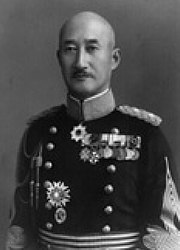| Gensui Count Terauchi Hisaichi | |
|---|---|
 Japanese General Count Terauchi Hisaichi | |
| Born | August 8, 1879 |
| Died | June 12, 1946 (aged 66) |
| Place of birth | Yamaguchi Prefecture, Japan |
| Place of death | Malaya |
| Allegiance | Empire of Japan |
| Service/branch |
|
| Years of service | 1900–1945 |
| Rank | Gensui (Marshal) |
| Commands held |
5th Division 4th Division Taiwan Army of Japan Northern China Area Army Southern Expeditionary Army Group |
| Battles/wars |
Russo-Japanese War Second Sino-Japanese War World War II |
| Awards | Order of the Rising Sun (1st class) |
Count Hisaichi Terauchi (寺内 寿一 Terauchi Hisaichi , 8 August 1879 – 12 June 1946) was a Gensui (or Marshal) in the Imperial Japanese Army and Commander of the Southern Expeditionary Army Group during World War II.
Biography[]
Terauchi was born in Yamaguchi prefecture, and was the eldest son of Gensui Count Terauchi Masatake, the first Governor-General of Korea and the 9th Prime Minister of Japan. He graduated from the 11th class of the Imperial Japanese Army Academy in 1900, and served in the Russo-Japanese War.
After the war, Terauchi returned to the Army Staff College and graduated from the 21st class in 1909. He spent time in as a military attaché in Germany and worked as a lecturer at the Military Academy.[1]
In early November 1919, he succeeded to the hereditary title of hakushaku (count) under the kazoku peerage system, upon the death of his father, and was raised in military rank to colonel. He became a major general in 1924. In September 1926, the Sanyō Main Line train he was riding on derailed in an accident that killed 34 people, but Terauchi was not injured.
Count Terauchi became Chief of Staff of the Chosen Army in Korea in 1927. After his promotion to lieutenant general in 1929, he was assigned command of the IJA 5th Division and later transferred to the IJA 4th Division in 1932. In 1934, he became commander of the Taiwan Army of Japan.
In October 1935 Terauchi was promoted to full general and became involved with the Kodoha faction in military politics. After the February 26 Incident in 1936 he was the army's choice as War Minister, which further intensified the conflict between the military and the civilian political parties in the Japanese Diet.

Count Terauchi and Koki Hirota at the Diet of Japan
The 2nd Count Terauchi returned to combat duty when he was given command of the North China Area Army immediately after the outbreak of the Second Sino-Japanese War. He was awarded the 1st class Order of the Rising Sun in 1938, and transferred to command of the Southern Expeditionary Army Group on 6 November 1941 and soon afterwards began devising war plans with Admiral Yamamoto Isoroku for the Pacific War.[2]
After leading the conquest of Southeast Asia, Terauchi established his headquarters in Singapore. Promoted to Gensui (Marshal) on 6 June 1943, he moved to the Philippines in May 1944. When this area came under threat, he retreated to Saigon in French Indochina. Upon hearing of the loss of Burma by Japan, he suffered a stroke on 10 May 1945.
680000 Japanese soldiers, in Southeast Asia were surrendered on his behalf in Singapore on 12 September 1945 by General Itagaki Seishiro. Terauchi personally surrendered to Lord Mountbatten on 30 November 1945 in Saigon and died of another stroke while in a prisoner of war camp in Malaya after the end of the war.[3]

Memorial to The 2nd Count Terauchi in the Japanese Cemetery Park, Singapore
The 2nd Count Terauchi surrendered his family heirloom wakizashi short sword to Lord Mountbatten in Saigon in 1945. The sword dates from 1413, and is now kept at Windsor Castle. It was almost the subject of a diplomatic incident in the mid-1980s, when Queen Elizabeth The Queen Mother wanted to place it on prominent display during a dinner held for Crown Prince Naruhito of Japan. However, her daughter, Queen Elizabeth II, vetoed the idea.[citation needed]
His grave is at the Japanese Cemetery Park in Singapore.
Notes[]
References[]
| Wikimedia Commons has media related to Hisaichi Terauchi. |
- Dupuy, Trevor N. (1992). The Harper Encyclopedia of Military Biography. New York: HarperCollins Publishers Inc. ISBN 0-7858-0437-4.
- Fuller, Richard (1992). Shokan: Hirohito's Samurai. London: Arms and Armor. ISBN 1-85409-151-4.
- Hayashi, Saburo (1959). Kogun: The Japanese Army in the Pacific War. Marine Corps. Association. ASIN B000ID3YRK.
- Ammenthorp, Steen. "Terauchi, Hisaichi". The Generals of World War II. http://www.generals.dk/general/Terauchi/Hisaichi_Count/Japan.html.
- Budge, Kent. "Terauchi, Hisaichi". Pacific War Online Encyclopedia. http://pwencycl.kgbudge.com/index.htm.
The original article can be found at Hisaichi Terauchi and the edit history here.